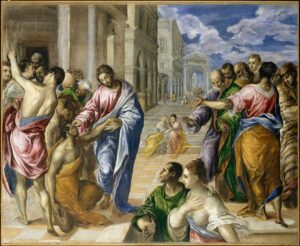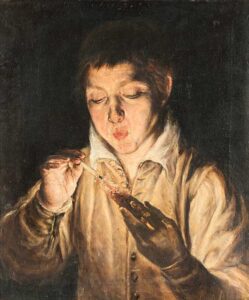
oil on canvas 119.4 cm (47 in) 146.1 cm (57.5 in)
Liviana Martin
If sometimes the destiny of a person is contained in the name (nomen omen as the Romans said, meaning the destiny is in the name), in this painter there are actually two of them: El concerns his Spanish period, Greco the Italian one. The artist was born in 1541 in Candia, capital of the island of Crete, then under Venetian dominion. His real name, with which he signs himself in many works, is Doménikos Theotokopoulos.
The exhibition ongoing at Palazzo Reale in Milan offers, after more than twenty years of absence from Italy, a vast selection of over 50 of his works, coming from the Prado Museum in Madrid, the Uffizi in Florence, the National Gallery in London, to name just a few, which are compared with the paintings of the most famous artists of the time, such as Titian, Tintoretto and Bassano.
We are in the mid-1500s, in the midst of the Renaissance, on the threshold of Mannerism. However, the first steps of the young Doménikos follow the traditional icons of Byzantine culture; the artist becomes an icon painter. From here comes his unmistakable trait, the elongated and slightly distorted figures, far from measure and proportion, peculiar qualities of the Italian Renaissance. His first work, Dormitio Verginis (1577), is flat, two-dimensional, in the Greek, oriental style. Soon this way of painting will be abandoned, but not forgotten, in favor of the Roman style Western art, when the artist moves to Venice and later to Rome. The ideas and innovations of the Serenissima seduced the imagination and influenced the choices of young artists. But, even when El Greco in Venice came into contact with painters of the caliber of Titian or Tintoretto, he did not passively absorb the lessons of the masters of color, but always maintained his own peculiar style, enriching it with brightness and perspective. His paintings are, apart from some magnificent portraits, almost all of a religious nature. It is the era of the Counter-Reformation, and the Catholic Church must build a barrier against Protestantism: artists follow its rules of orthodoxy even in the pictorial field. Even if at times El Greco deviates from it, depicting the Madonna breastfeeding her child, an image that the doctrine of the Counter-Reformation did not consider decorous.
A beautiful painting on display, the Annunciation, reinterprets elements taken from Titian and Tintoretto in his own style. In a closed environment, which opens onto a sky with extraordinary colours, the Virgin Mary looks towards the Angel portrayed in dazzling colours. The characters’ gestures and expressions convey their feelings: the amazement painted on the young woman’s face at the announcement (she will have a son and he will be the Messiah) is contrasted with the firm and reassuring expression of the divine messenger. The two figures speak to each other and to us.
Also in another work on display, the Last Supper, El Greco takes up elements typical of Tintoretto: the brightness, the gestures of the characters, the theatrical sense of the representation. The figures of Christ and the Apostles are arranged around a table, where objects stand out, including a knife and a fork (believed to be symbols of the devil) placed near Judas, the traitor. While the other characters have bright, light robes, Judas is depicted from behind, with a darker, almost gloomy robe, to highlight his wickedness. In these paintings every detail is symbolic; everything communicates messages to us. The wonderful play of light, which is reflected on the clothes, seems to come almost from inside; it is a divine light.
El Greco arrived in Rome in 1570 to obtain important commissions, recommended by the powerful Farnese family. In this city, the center of Renaissance culture, where all the most important artists worked in the churches and palaces of the Pope, El Greco discovered Michelangelo, towards whom he felt great admiration and who would influence his painting in the anatomical rendering of the human body. painted in a twisted “serpentine” way.
The Healing of the Blind is influenced by the Roman period. In the foreground, painted with soft brushstrokes, Christ puts his fingers in the eyes of a blind man and restores his sight, just as the Church spreads its light against the darkness of the heresies. In the foreground, a string of Roman-style architectural elements.

oil on canvas. 60.5 cm (23.8 in) 50.5 cm (19.8 in)
But the protection of the Farnese family did not last long, his paintings with elongated shapes were no longer popular. Thus, the artist moves again and goes to Spain with the hope of obtaining some prestigious assignment and finally finding a homeland. However, he remains disappointed once again because the innovative power of his art is not fully understood. He then retreats to Toledo, a marginal city deeply rooted in Orthodox Catholicism. Here he paints a series of masterpieces in which the figures are increasingly elongated; the colors become unnatural. After creating small paintings, he works on colossal works. An example of this is the beautiful Saint Martin and the Beggar, where the saint, according to tradition a Roman soldier from the 4th century, is dressed in typical 17th century clothing with armor and gorget. Martin towers on a white horse, intent on cutting off his cloak to give it to the poor, almost naked beggar. The figures are monumental; the facial expressions express sweetness. El Greco fits perfectly into the narrative of the Church of the Counter-Reformation, which sees the poor as the suffering people and the saint as the warrior of faith. The background, which will be repeated in many of his other works, is Toledo. The same city, illuminated by lights that seem to be flashes coming from the sky, almost ghostly, is the background of another work, the agonizing Christ, where the whiteness of Christ’s body stands out against the black of the sky with fringed clouds that interrupt the darkness.
In the last part of his life the artist increasingly accentuated this anti-realistic way of painting: the Baptism of Christ is a perfect example. Here, the style is almost expressionist, El Greco abandons all naturalism to represent his subjective reality, where bodies, sky and earth merge with supernatural effects.
The exhibition ends with the only work painted by the artist on a mythological subject. It represents the end of Laocoön narrated by Greek myths. Laocoön is a Trojan priest who warns his fellow citizens of the danger they will face if they let the horse created by the Greeks enter the city walls to conquer it. The goddess Athena, protector of the Greeks, sends snakes to kill Laocoön and his sons. In the painting, the priest, in a disjointed pose, collapsed on the ground, tries to kill the snake. A son on his right appears to dance with the reptile, creating a sort of circle that encloses the city of Toledo. Three enigmatic figures (the Three Fates?) observe the death of those who wanted to challenge the divinity and were punished. Frayed clouds appear in an eerie sky. It is a mysterious work, full of messages yet to be interpreted, which seals the painter’s greatness.
After a long oblivion, El Greco’s painting was rediscovered in the 19th century. Painters such as Cezanne, Delacroix and Sargent admired him and drew inspiration from him. Picasso himself, in his most revolutionary painting, Les Demoiselles d’Avignon, was partly inspired by the contortions of El Greco. Perhaps also due to its modernity, the exhibition has attracted a great number of spectators since its opening.
El Greco, Palazzo Reale di Milano from 11/10/2023 to 11/02/2024, tickets – 15 euro
